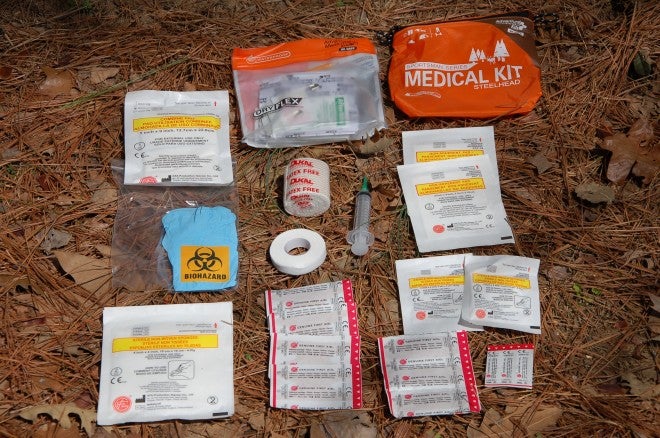Building a Hunting Camp Med Kit
Dr. John Woods 07.15.14

All in all, hunting is a pretty safe activity, but things do happen around the camp, out in the field or woods, or conducting any number of everyday outdoor tasks. Every hunter should have some kind of basic or extended medical first aid kit in their primary vehicle, and another one around the camp house or assembly area. They are easy to make up and there is no excuse not to have one.
I can’t count the times that we have had cut fingers, blisters, bruises, whams, bangs, pinched skin, and all sorts of minor accidents around hunting camp. Luckily and knock on wood, we have been very fortunate that nobody in nearly 25 years has been seriously hurt at our hunting camp. Still little boo-boos do happen and there needs to be a first aid kit around to handle it.
If something more serious were to occur in your camp, then you need to know how to quickly respond to that. Chainsaw cuts are common and dangerous. Broken bones from tree stand falls are the No.1 accident in deer camp. Rolling over an ATV can be serious. Let’s not even talk about any kind of accidental gunshot wound or a puncture with an archery broadhead. And think about the older hunters with potential for a heart attack. It happens.
Let me then say up front, if you don’t have a doctor in your camp, then it would be a great idea for more than one member or camp hunter to have taken a basic certified first aid course. Besides knowing to call 911 immediately, every hunter should know how to control bleeding, immobilize a broken bone, treat a head or back injury properly, and what to do in the event of a heart attack in camp. The idea is to keep somebody alive until the EMTs can get there.
You can either buy a basic first aid kit or actually create one yourself from multiple choices of supplies. We have both in my deer camp. We bought a metal box medical kit with plenty of gauze bandages, compresses, band aids, some antiseptic cream, tweezers, and such.
If you follow the zombie apocalypse movement or the survival movement via some of the many good web sites, you can study in depth about other first aid products to add to your kit. Many are going with the clot stoppers now, and that is probably not a bad idea. I would suggest adding several cold packs, too.
Whatever your basic kit contains, go buy double that to have on hand. This is especially the case with having many types and sizes of band aids in the kit. Everything from tiny butterfly bands to big patches for abrasions will be used. Double up on the antiseptics, too, and also a wound flush besides water. Rubbing alcohol is not a good choice for that.
Put in some aspirin or Tylenol®, but make sure there are no allergies involved. Don’t make things worse. Add a tube of burn cream and insect bite relief as well. Think about wasp stings or worse yet, snake bites. The procedures for that have changed dramatically.
Besides common rolls of gauze, add some eye patch cloths, a couple elastic wraps for sprains, bandage tape, cotton balls, and cotton swabs.
Other supplies to keep on hand around camp include plenty of bug repellent, including tick and red bug spray. Have several bottles of hand sanitizer around the camp, game cleaning rack, and elsewhere. A bottle or tube of sunshine skin protectant is a good idea, too.
All of this first aid supplies and consumables should be stored in a (or multiple) durable bag and be easy to get to. I would almost bet that every hunter in camp has an old backpack or fanny pack at home lost the closet somewhere. These would be perfect for a hunting camp first aid kit, so long as everybody knows what they are and where they are.
One thing I intend to do this season (and I am working on it now) is to build a “GHB” or Get Home Bag for the truck. I will have some basic first aid supplies in that bag. I also plan to put a small kit inside the storage box I have on the back of my ATV.
Think about it. Where are accidents most likely to happen on hunting property? It has to be either around the game cleaning rack, campfire, or out in the hunting field around a hunting stand or such. You need to have a kit out in the field as well.
Pre-planning for camp accidents or small incidents is not a fun topic, but it is important. Even a small cut or abrasion can be aggravating if there is nothing around to treat it quickly. It needs to be cleaned, bleeding stopped, applied with antiseptics, and wrapped. If it requires stitches, forget it. Apply pressure, wrap it up, and get to medical care ASAP.
Hopefully your hunting camp will have a safe year and hunting season. It’s still a prudent idea to have some first aid supplies on hand and know how to use them.